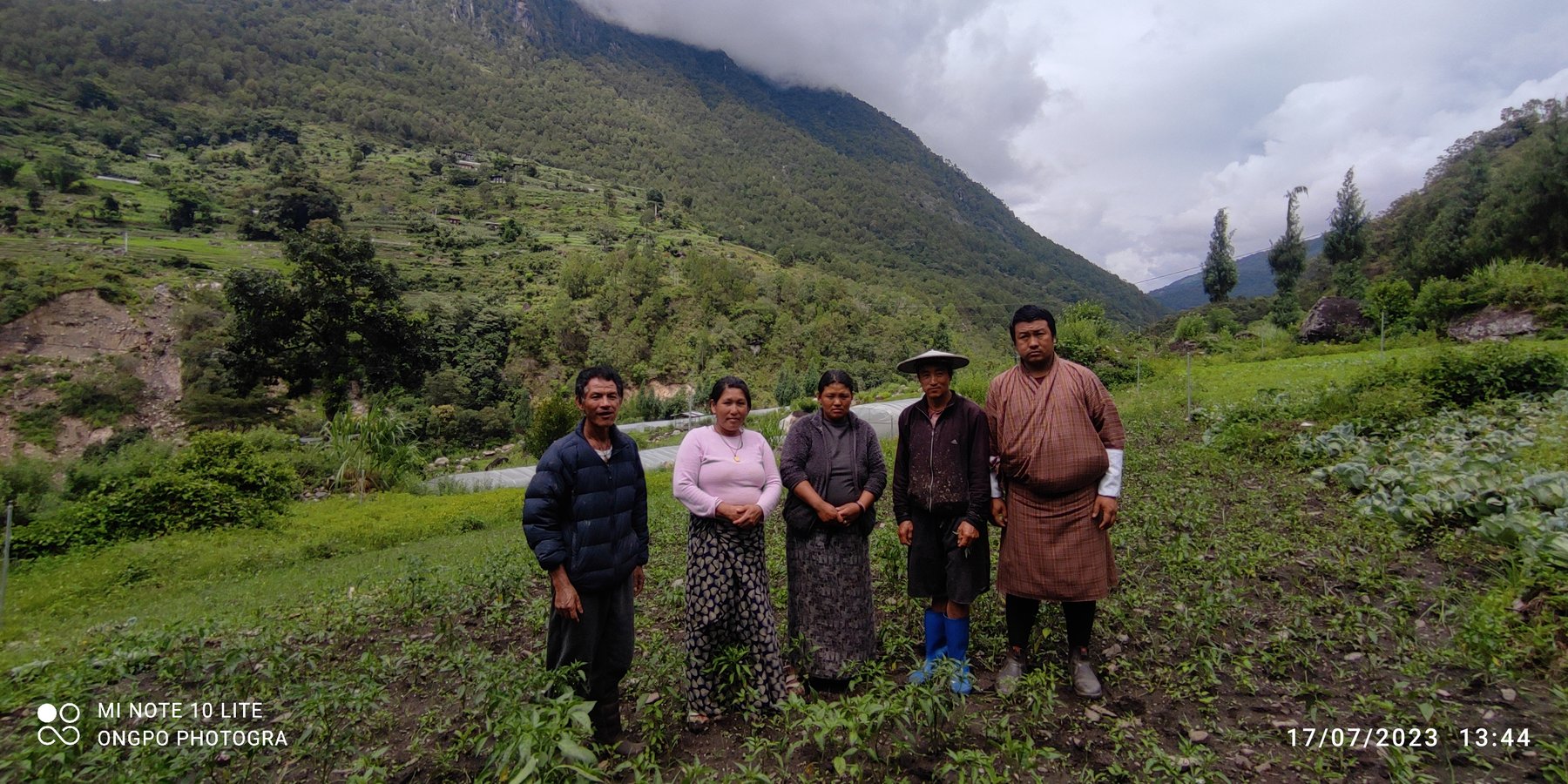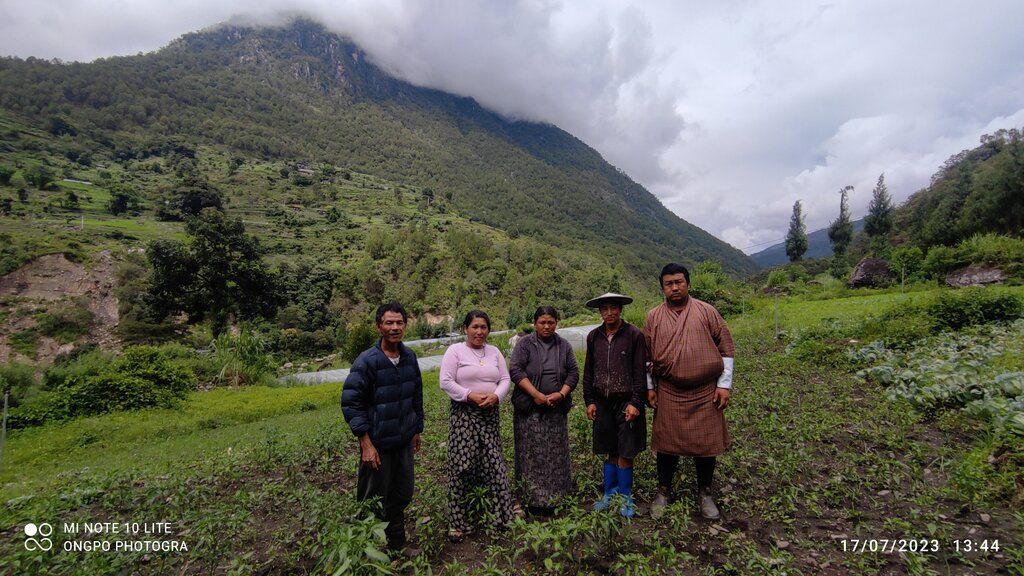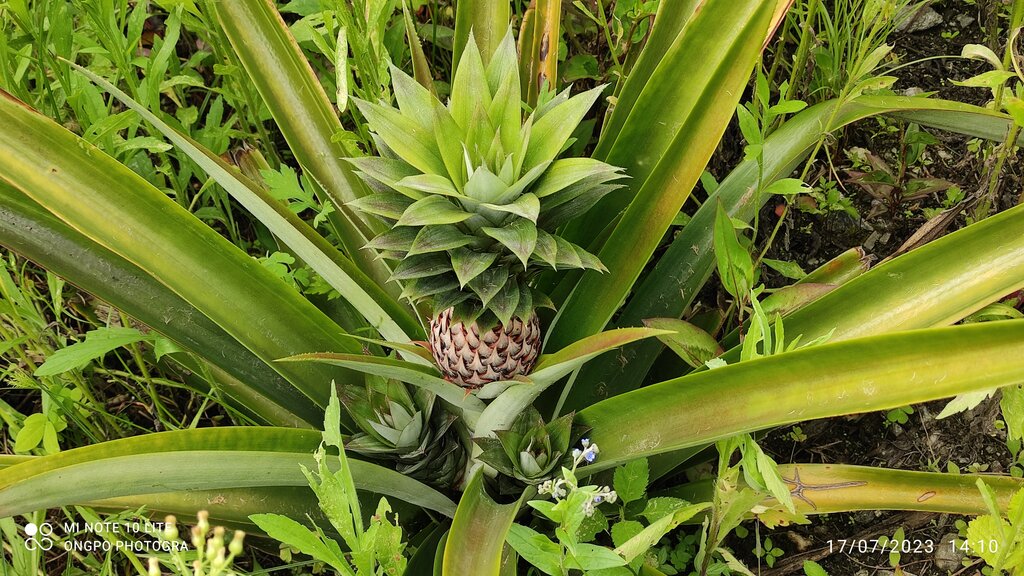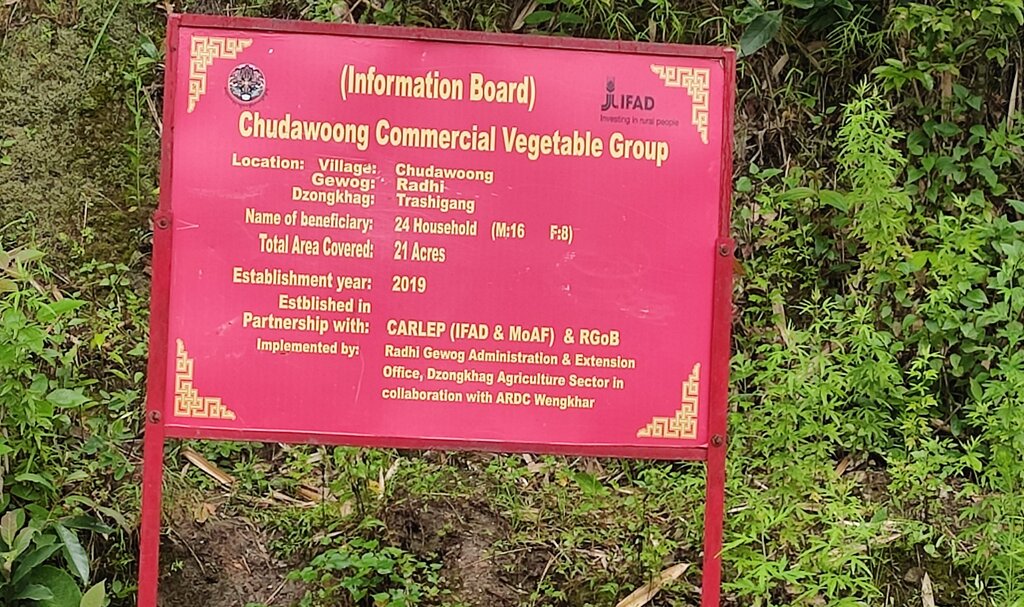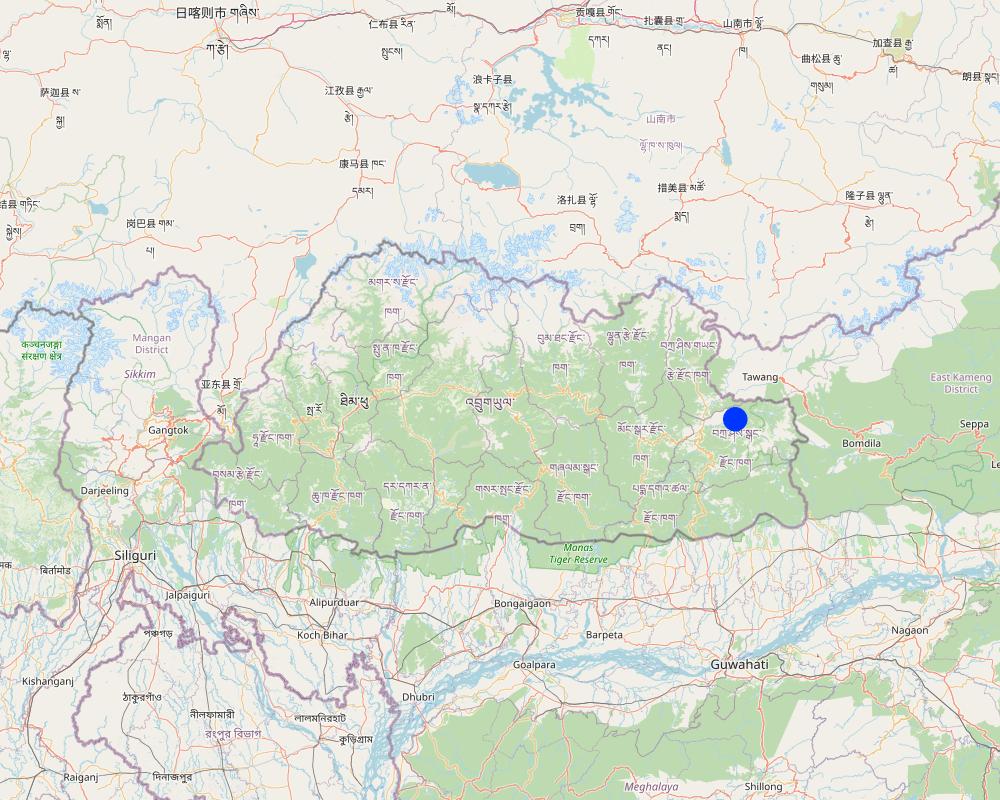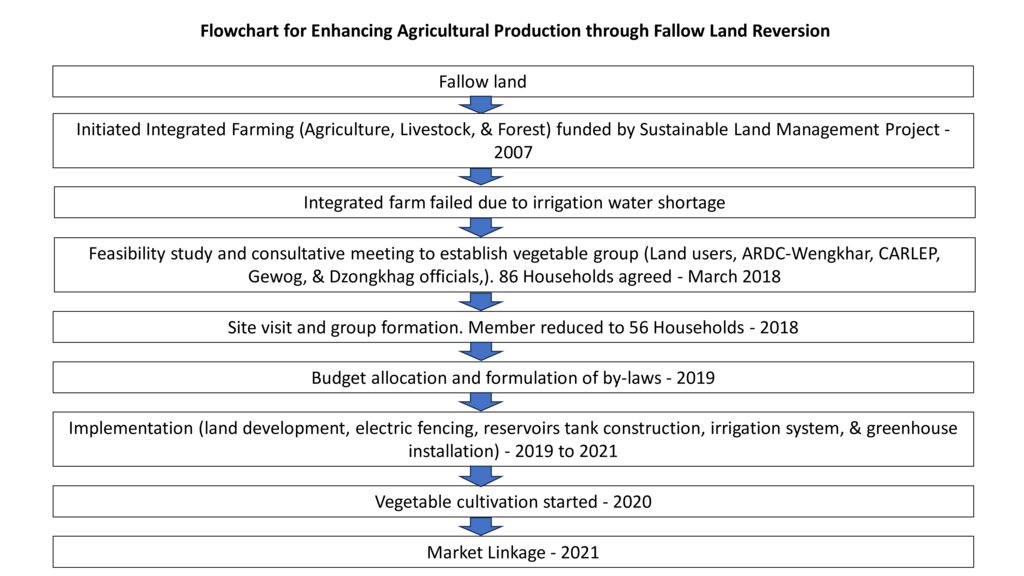Enhancing Agricultural Production Through Fallow Land Reversion [Bhutan]
- Creation:
- Update:
- Compiler: Nima Dolma Tamang
- Editor: Tashi Wangdi
- Reviewers: William Critchley, Rima Mekdaschi Studer
approaches_6890 - Bhutan
View sections
Expand all Collapse all1. General information
1.2 Contact details of resource persons and institutions involved in the assessment and documentation of the Approach
Key resource person(s)
land user:
Yeshey Kinzang
17675628
Pakaling Chiwog, Radhi Gewog, Trashigang Dzongkhag
Bhutan
land user:
Jamtsho Ten
17642994
Pakaling Chiwog, Radhi Gewog, Trashigang Dzongkhag
Bhutan
land user:
Dendup Pema
77874171
Pakaling Chiwog, Radhi Gewog, Trashigang Dzongkhag
Bhutan
land user:
Pelden Tshering
17558529
Pakaling Chiwog, Radhi Gewog, Trashigang Dzongkhag
Bhutan
land user:
Zangmo Choni
77753201
Pakaling Chiwog, Radhi Gewog, Trashigang Dzongkhag
Bhutan
Agriculture Extension Officer:
Wangchen Pema
17436036
pemawangchen2010@gmail.com
Radhi Gewog, Trashigang Dzongkhag
Bhutan
Name of project which facilitated the documentation/ evaluation of the Approach (if relevant)
Strengthening national-level institutional and professional capacities of country Parties towards enhanced UNCCD monitoring and reporting – GEF 7 EA Umbrella II (GEF 7 UNCCD Enabling Activities_Umbrella II)Name of the institution(s) which facilitated the documentation/ evaluation of the Approach (if relevant)
National Soil Services Centre, Department of Agriculture, Ministry of Agriculture & Livestock (NSSC) - Bhutan1.3 Conditions regarding the use of data documented through WOCAT
When were the data compiled (in the field)?
17/07/2023
The compiler and key resource person(s) accept the conditions regarding the use of data documented through WOCAT:
Yes
1.4 Reference(s) to Questionnaire(s) on SLM Technologies
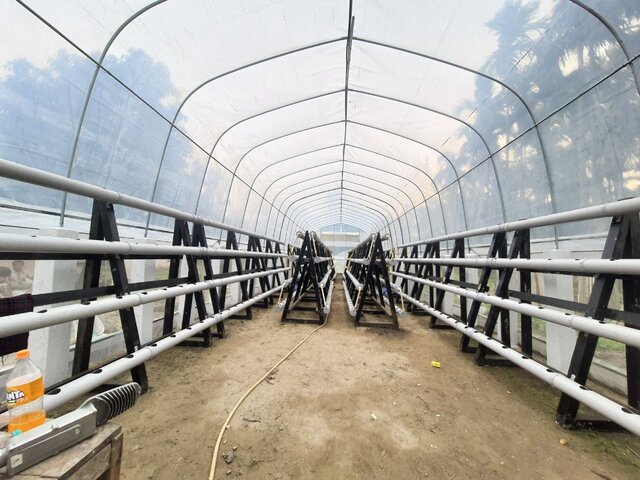
Protected Agriculture for High Value Crops [Bhutan]
Protected agriculture (controlled environment agriculture) is the use of technology to modify the growing environment for crops to extend the growing period and increase yields. It can include greenhouses, shade nets or polytunnels. This technology is moderately expensive therefore it is used only for the cultivation of high-value crops and …
- Compiler: Nima Dolma Tamang
2. Description of the SLM Approach
2.1 Short description of the Approach
The approach is to enhance production of local vegetables and fruits through fallow land restoration - under a group established for the purpose.
2.2 Detailed description of the Approach
Detailed description of the Approach:
This approach of reverting fallowed land to productivity encompasses leasing land, working in groups, promoting SLM technologies, and forging market linkages. In this example, the land belongs to the community Lhakang (temple) where the community used to grow maize and pulses to be offered to the Lhakang. However, with increased wild animal depredation, and shortages of irrigation water the land was left fallow. In 2019, with support from the government and the Commercial Agriculture and Resilient Livelihoods Enhancement Program (CARLEP), International Fund for Agriculture Development (IFAD) Project, interested farmers from the community came together, leased the land, and started cultivating vegetables. The reverted fallow land is thus cultivated by the Chuthawoong Commercial Vegetable Farming group which is divided into three subgroups – one of women only - to increase efficiency. The group consist of seven and nine men in two male groups and seven women in one female group. There are no youths involved. The initial development involved the implementation of various SLM technologies such as stone bunding and napier grass strips to reduce soil erosion. Developing market linkages is another characteristic of the approach. The Regional Agricultural Marketing and Cooperatives (RAMCO) linked the land users with three schools to sell vegetables. Furthermore, the group signed a contract with Bhutan Agro Industries Limited (BAIL), Lingmithang (state-owned company) to supply dragon fruit and pineapple for processing.
The main aims and objectives of the approach are to become self-sufficient in vegetables and reduce imports, improve the livelihood and income of the land users and retain youth in agriculture through agricultural mechanization. The methods involved in implementing the approach were consultation among the community leaders and land users, and higher-level consultation with the Gewog Leaders and Dzongkhag Officials, consultation with the Agriculture Research and Development Center (ARDC) Wengkhar and with CARLEP project members.
Stages of implementation included conducting a feasibility study, followed by consultation meetings with the land users. Land development was carried out along with the installation of facilities including fencing, greenhouses, irrigation, and irrigation water storage tanks. After that, the group was formed and bylaws established. Seeds and seedlings were provided by the government.
Stakeholders involved include Gewog officials to develop land lease agreements. The Gewog Extension officer was involved throughout the process in providing guidance and support concerning irrigation, land development, vegetable and fruit cultivation and others. Dzongkhag officials were involved in the feasibility study and planning, and as one of the funding source. CARLEP act as the biggest funding agency to facilitate infrastructure support along with carrying out monitoring activities. ARDC-Wengkhar provided technical support and RAMCO established market linkages.
Land users benefit from increased household income and being self-sufficient in vegetables. The major challenges faced by the land users are distance, as the land is located far away from their houses, and marketing issues, as total production remains above market demand.
2.3 Photos of the Approach
2.5 Country/ region/ locations where the Approach has been applied
Country:
Bhutan
Region/ State/ Province:
Trashigang Dzongkhag
Further specification of location:
Pakaling Chiwog, Radhi Gewog,
Map
×2.6 Dates of initiation and termination of the Approach
Indicate year of initiation:
2017
2.7 Type of Approach
- recent local initiative/ innovative
2.8 Main aims/ objectives of the Approach
The main aim of the approach is to reduce imports by increasing vegetable production, Improve the livelihood and living standard of the land users and retain youth in agriculture through agriculture mechanization.
2.9 Conditions enabling or hindering implementation of the Technology/ Technologies applied under the Approach
availability/ access to financial resources and services
- enabling
The approach received financial support from various organizations. Dzongkhag Administration (Royal Government of Bhutan) provided Nu. 500,000/-, followed by Nu. 850,000/- from CARLEP-IFAD project and Nu. 90,000 from BAIL.
institutional setting
- enabling
There is a very good collaboration between the institutions such as Schools and with the BAIL.
collaboration/ coordination of actors
- enabling
Although financial support was provided, the community came together to contribute labour for 300 days per household. The farm is Local Organic Assurance System (LOAS) certified and there is a common understanding to follow the organic guidelines.
legal framework (land tenure, land and water use rights)
- enabling
The land belongs to the community Lhakang of Pakaling Chiwog. Out of 100 households, only 27 households were interested and engaged in renting the land for crop production. The Local government had facilitated and the lease agreement was drawn between the Lhakhang and community. The land users have to pay a sum of Nu.7500/- to the Lhakang. The group members can cultivate the land for all time while non group members have no right to object or raise any issues. In case, If the group disintegrates in future, any outsider or member of the community can take up the farming activity with no objections from the others.
knowledge about SLM, access to technical support
- enabling
The land users had access to technical support Gewog Extension Officer, the Dzongkhag Agriculture officer and Researchers from the ARDC-Wengkhar.
markets (to purchase inputs, sell products) and prices
- enabling
The groups have a linkage to supply vegetables to the schools and signed the contract with the BAIL, Lingmithang
workload, availability of manpower
- hindering
The land users are engaged in rice cultivation in their own fields and weaving. Therefore, the availability of manpower in the revived land is minimal.
3. Participation and roles of stakeholders involved
3.1 Stakeholders involved in the Approach and their roles
- local land users/ local communities
Land users
Contributed labour during the establishment of the farm and involved in the cultivation of the vegetables. They are the main actors in the approach.
- SLM specialists/ agricultural advisers
Gewog Extension officer, Dzongkhag Agriculture officer, Researchers from ARDC-Wengkhar.
Provides technical support such as training in vegetable cultivation, and setting up irrigation systems.
- teachers/ school children/ students
Teachers engaged in School Feeding Programme
Purchase farm produce from the group.
- private sector
BAIL
Provides fund support and purchase farm produce for processing
- local government
Gup, Tshokpa
Involved in developing the land lease agreement.
- national government (planners, decision-makers)
Royal Government of Bhutan
Conduct a feasibility study, and provide financial support.
- international organization
CARLEP-IFAD
Provide fund sources for the establishment of the farm and conduct monitoring.
3.2 Involvement of local land users/ local communities in the different phases of the Approach
| Involvement of local land users/ local communities | Specify who was involved and describe activities | |
|---|---|---|
| initiation/ motivation | self-mobilization | The land was fallow for 27 years and in 2007 the land users tried to restore the land by initiating Integrated Agriculture Farm where they cultivated forest trees, crops and livestock. However, with the unavailability of water, the integrated farm was not successful. People informed the government about the need for a water pump and the Gewog Gup shared it in a higher meeting. This was the initiation of the Land restoration approach. |
| planning | interactive | There were numerous meetings involving the land users, Gewog officials, Gewog Extension Officer, Dzongkhag officials, officials from ARDC-Wengkher and CARLEP. |
| implementation | interactive | Land users and all the stakeholders were involved in the implementation of the approach. |
| monitoring/ evaluation | interactive | External monitoring is done by Audit officers from the stakeholders involved, Audit officers from Bumthang for CARLEP, and Audit officers from Samdrup Jongkhar for RGoB. Internal monitoring is done by the Treasurer of the group. |
3.3 Flow chart (if available)
Description:
The flowchart has been developed in consultation with the land users and Gewog Agriculture Extension Officer.
Author:
Nima Dolma Tamang
3.4 Decision-making on the selection of SLM Technology/ Technologies
Specify who decided on the selection of the Technology/ Technologies to be implemented:
- all relevant actors, as part of a participatory approach
Explain:
All relevant actors were involved in the selection of the technology. Gewog Extension Officer, Dzongkhag Officials, and Researchers from ARDC-Wengkhar provided technical inputs and the land users provided valuable area-specific knowledge based on their experience.
Specify on what basis decisions were made:
- evaluation of well-documented SLM knowledge (evidence-based decision-making)
- personal experience and opinions (undocumented)
4. Technical support, capacity building, and knowledge management
4.1 Capacity building/ training
Was training provided to land users/ other stakeholders?
Yes
Specify who was trained:
- land users
If relevant, specify gender, age, status, ethnicity, etc.
The training was provided to 7 women and 16 men.
Form of training:
- demonstration areas
- public meetings
Subjects covered:
Soil nutrient management, vegetable production technique, compost making and others.
4.2 Advisory service
Do land users have access to an advisory service?
Yes
Specify whether advisory service is provided:
- on land users' fields
- at permanent centres
- On social media (WeChat)
Describe/ comments:
Advisory service in the form of hands on training at site, at gewog centers and online social media forums such as WeChat.
4.3 Institution strengthening (organizational development)
Have institutions been established or strengthened through the Approach?
- yes, moderately
Specify the level(s) at which institutions have been strengthened or established:
- local
- regional
Describe institution, roles and responsibilities, members, etc.
The role of the group is to meet their objectives through vegetable production and motivate one another.
Specify type of support:
- financial
- capacity building/ training
- equipment
Give further details:
The land users benefit from the approach as the income generated is useful in sustaining their livelihoods. Land users' capacity was built as they were engaged in the training and implementation of various SLM technologies. The group received equipment such as an irrigation system, electric fencing, greenhouse and others.
4.4 Monitoring and evaluation
Is monitoring and evaluation part of the Approach?
Yes
Comments:
The monitoring and evaluation are done by the donors to evaluate the success of the approach. The monitoring includes site visits and verifying the documents on the purchase and sale of the inputs of the produce and its economic benefits to the land users.
If yes, is this documentation intended to be used for monitoring and evaluation?
No
4.5 Research
Was research part of the Approach?
No
5. Financing and external material support
5.1 Annual budget for the SLM component of the Approach
If precise annual budget is not known, indicate range:
- 100,000-1,000,000
Comments (e.g. main sources of funding/ major donors):
CARLEP project and Royal Government of Bhutan
5.2 Financial/ material support provided to land users
Did land users receive financial/ material support for implementing the Technology/ Technologies?
Yes
If yes, specify type(s) of support, conditions, and provider(s):
Following are the financial support received by the group. 16 numbers of fabricated greenhouses where the land user paid 20% of the amount and 80% was funded by the donor. 100% funding was provided by the donor for the water pump, electric fencing, internal networking of irrigation, cement, grass-cutting machine, seeds and seedlings, water tank and curing shed construction. Labour input was contributed by the land users. The total of Nu. 90,00,000/- (Ninety hundred thousand) was supported for the project.
5.3 Subsidies for specific inputs (including labour)
- equipment
| Specify which inputs were subsidised | To which extent | Specify subsidies |
|---|---|---|
| Water pump, grass cutting machine | fully financed | Water pump and grass cutting machine 100% funded by the doner. |
- agricultural
| Specify which inputs were subsidised | To which extent | Specify subsidies |
|---|---|---|
| seeds | fully financed | By RGoB. |
| Land development | fully financed | 100% machine contribution was done by the government with labour contribution from land users. |
- construction
| Specify which inputs were subsidised | To which extent | Specify subsidies |
|---|---|---|
| roads | fully financed | By government. |
| Greenhouse, electric fencing, internal networking irrigation system, curing shed | partly financed | For greenhouses, 80% was funded by the doner, 20% by land users. For electric fencing, internal networking irrigation system, cement, pipes, curing shed and water storage tank materials were funded 100% by the doner with labour contribution made by land users |
- infrastructure
| Specify which inputs were subsidised | To which extent | Specify subsidies |
|---|
If labour by land users was a substantial input, was it:
- voluntary
Comments:
Labour and locally available materials were contributed by the land users.
5.4 Credit
Was credit provided under the Approach for SLM activities?
No
5.5 Other incentives or instruments
Were other incentives or instruments used to promote implementation of SLM Technologies?
No
6. Impact analysis and concluding statements
6.1 Impacts of the Approach
Did the Approach empower local land users, improve stakeholder participation?
- No
- Yes, little
- Yes, moderately
- Yes, greatly
The approach improved farm income and their livelihood. It improved stakeholders participation such as schools, Extension officials, and BAIL.
Did the Approach enable evidence-based decision-making?
- No
- Yes, little
- Yes, moderately
- Yes, greatly
The approach enabled land users and the stakeholders involved to make decisions based on the findings. For example, the land users learned that potato cultivation was not profitable due to insect infestation, so they opted for chili cultivation in the next season.
Did the Approach help land users to implement and maintain SLM Technologies?
- No
- Yes, little
- Yes, moderately
- Yes, greatly
Land users implemented stone bunding and napier grass plantation to reduce soil erosion which they have maintained very well as it was very efficient in controlling soil erosion. The Napier grass was also sold creating income opportunities.
Did the Approach improve knowledge and capacities of land users to implement SLM?
- No
- Yes, little
- Yes, moderately
- Yes, greatly
The land users were involved in the SLM technologies establishment under the supervision of the SLM specialist leading to improved knowledge.
Did the Approach improve knowledge and capacities of other stakeholders?
- No
- Yes, little
- Yes, moderately
- Yes, greatly
The stakeholders' knowledge was improved greatly as the challenges faced by the land users were forwarded to the stakeholders (SLM specialist/RAMCO). The stakeholders were to address the challenge and in the process, the stakeholder had to develop new techniques and test them on the field which led to improved knowledge of both the parties.
Did the Approach build/ strengthen institutions, collaboration between stakeholders?
- No
- Yes, little
- Yes, moderately
- Yes, greatly
All the stakeholders and land users worked together to achieve a common goal i.e. increased income for land users and use of fallow land for agriculture production, reduce import.
Did the Approach empower socially and economically disadvantaged groups?
- No
- Yes, little
- Yes, moderately
- Yes, greatly
If the land users are interested, irrespective of their wealth and status, all the land users in the community are allowed to participate in the approach. Therefore, economically disadvantaged groups involved in farming activity have improved livelihood and increased household income.
Did the Approach improve gender equality and empower women and girls?
- No
- Yes, little
- Yes, moderately
- Yes, greatly
The approach has two subgroups with heterogenous members (male and female) and one subgroup has only female members encouraging women's participation in decision-making.
Did the Approach encourage young people/ the next generation of land users to engage in SLM?
- No
- Yes, little
- Yes, moderately
- Yes, greatly
The approach was initiated to encourage youths to participate in agricultural activities. However, there is no interest shown by the youths. This could be due to low-income generation, poor market access and less or no recreation facility in the approach site.
Did the Approach lead to improved food security/ improved nutrition?
- No
- Yes, little
- Yes, moderately
- Yes, greatly
The approach enabled land users to be self-sufficient in vegetables during winter and also generate income by selling the produce. Thus, making the community self-sufficient in vegetables and certain fruits.
Did the Approach improve access to markets?
- No
- Yes, little
- Yes, moderately
- Yes, greatly
The approach linked the land users to the market such as schools and processing units (BAIL).
Did the Approach lead to employment, income opportunities?
- No
- Yes, little
- Yes, moderately
- Yes, greatly
The approach improved the income of the land users as they were able to buy school necessities for their children from the income generated by selling vegetables from the approach site.
6.2 Main motivation of land users to implement SLM
- increased production
The additional cultivation in the area improved food self-sufficiency and food security. Therefore, increased production due to improved soil quality is one of the main motivating factors to adopt SLM.
- increased profit(ability), improved cost-benefit-ratio
The farmers do not have a significant contribution to the establishment of the SLM, major activities were funded by the government. So all the benefits obtained are profits for the land users. Therefore, this is another important motivation for the adoption of the approach.
6.3 Sustainability of Approach activities
Can the land users sustain what has been implemented through the Approach (without external support)?
- yes
If yes, describe how:
The approach is sustainable. Even though the market for large quantities of produce is not available. There is a market linkage created with local consumers. Further, the land users can link with the relevant stakeholders to export the produce. Moreover, the land users were well trained in vegetable production to sustain without external support.
6.4 Strengths/ advantages of the Approach
| Strengths/ advantages/ opportunities in the land user’s view |
|---|
| Improved production and increased cultivable land is major strength of the approach. With the fallow land reversion and sufficient irrigation water, the land is is able to produce large amount of crop. |
| The approach contributed to improved household income. By selling the crops grown in the revived area, the land users get additional income to support their livelihood. |
| Strengths/ advantages/ opportunities in the compiler’s or other key resource person’s view |
|---|
| Improved nutrition to the school children as the quality of organic vegetables supplied by the group is better than the imported produce grown in a conventional system with the use of pesticides especially from India. |
| Reduces import as the group sell their produce to the schools and nearby community. The demand for vegetable is met by domestic production, therefore there are fewer commodities imported. |
6.5 Weaknesses/ disadvantages of the Approach and ways of overcoming them
| Weaknesses/ disadvantages/ risks in the land user’s view | How can they be overcome? |
|---|---|
| The land is far from the houses of the land users making it difficult for the land users to give constant management and care. | |
| Radhi is known as the "Rice bowl of eastern Bhutan" and it is also famous for the Bhuray (type of fabric) gho and kira (National dress). Therefore the reverted land is neglected during peak rice production season and labour demanded by the weaving of the Buray gho and kira high. | |
| Due to less market and surplus production. Land users are challenged with marketing of their crops. | Encourage middlemen to purchase their produce and sell it to other parts of the country. |
7. References and links
7.1 Methods/ sources of information
- field visits, field surveys
There were six informants, five land users and one Gewog Extension Officer.
- interviews with land users
five land users
- interviews with SLM specialists/ experts
One, gewog extension officer
7.2 References to available publications
Title, author, year, ISBN:
Lhamo C. (2021). Agricultural production through fallow land reversion with numerous interventions. CARLEP. Retrieved from https://carlep.gov.bt/agricultural-production-through-fallow-land-reversion-with-numerous-interventions/
Available from where? Costs?
https://carlep.gov.bt/agricultural-production-through-fallow-land-reversion-with-numerous-interventions/
Links and modules
Expand all Collapse allLinks

Protected Agriculture for High Value Crops [Bhutan]
Protected agriculture (controlled environment agriculture) is the use of technology to modify the growing environment for crops to extend the growing period and increase yields. It can include greenhouses, shade nets or polytunnels. This technology is moderately expensive therefore it is used only for the cultivation of high-value crops and …
- Compiler: Nima Dolma Tamang
Modules
No modules


